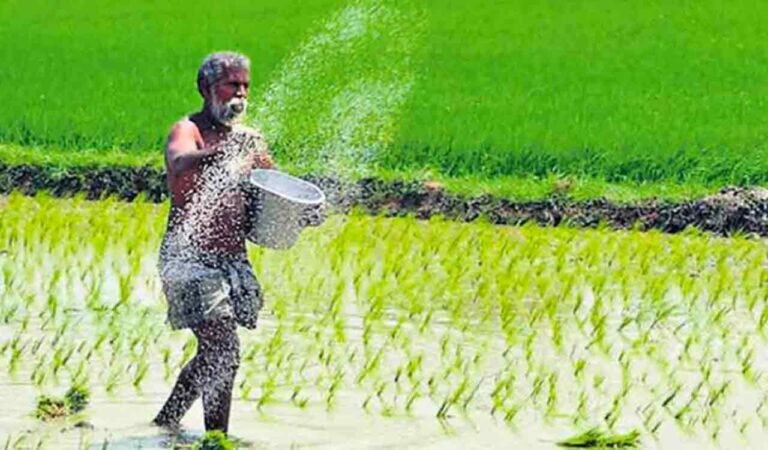The study titled “Annual Survey on Status of Marginal Farmers in India” highlights that 84% of marginal farmers are reluctant to give up farming despite low profits and natural disasters,
Posted Date – 12:15 AM, Fri – 21 April 23

representative image.
New Delhi: About 70 percent of more than 6,000 marginalized farmers engage in off-farm activities for income support, but 84 percent of them do not want to sell their land for other economic activities, a new study finds.
According to a study conducted by the India Rural Transformation Foundation and Sambodhi’s partnership Development Intelligence Unit (DIU), marginal farmers are mainly engaged in non-farm activities such as wage labor and livestock management to supplement their income. According to the 10th Agricultural Census 2015-16, small and marginal farmers who own less than two hectares account for more than 86% of all farmers in India, but they own only about 47% of the crop area.
The study titled “Annual Survey on the Status of Marginal Farmers in India” highlights that 84% of marginal farmers are reluctant to give up farming and are not interested in selling their land to pursue their own ventures despite their meager profits and exposure to natural disasters in other economies Activity. Broken down by land holdings, the higher the land holdings, the greater the tendency to farm less, while those with the least land holdings want to keep farming.
According to the survey, 93.9% of farmers with 0-0.5 mu of arable land and 2-2.5 mu of arable land are willing to continue farming. In contrast, only 5.32% of the smallest landowners and 14.76% of the largest landowners wanted to reduce such activities. Some 10.99% chose to reduce it in due course, while only 2.77% wanted to leave farming altogether. “Responses have all been opposite, with a lack of pathways indicating the vulnerability of marginal farmers’ livelihood portfolios, especially when hit by similar pandemic shocks,” the survey said.
The data showed that Indian farms became more fragmented between 2010-11 and 2015-16, with farms continuing to be unevenly distributed. During this period, the proportion of small and marginal farmers increased from 84.9% to 86.2%, an increase of about 9 million households, while the total number of operating households increased from 138 million to 146 million. In addition, each of these 126 million farmers owns an average of 0.6 hectares of land, which is not enough to generate a surplus to sustain the family economy.
To supplement their meager income from cultivation, 68.3% of marginal farmers engage in other income-generating activities such as daily wage labor (78%), occupational business (60%), off-farm business (18%) and animal husbandry (12%) and income-generating activities. wage employment (12%). According to the study, the average land size of a marginal farmer is about 1.22 acres. Only 56% of marginal farmers have access to irrigation and practice only rainfed agriculture. About 69% of the farmers sell their crops or by-products with an average annual sales of Rs 60,510 and the median annual agricultural sales is estimated at Rs. 40,000.
The average income of a marginal farmer who also does daily wage labor to supplement farm income is Rs 1,00,275 in the past year. The survey also explores how the economic conditions of marginalized farmers have changed over the past three years. Some 34.7% said their situation had improved over the past three years, while 2.42% said it had improved significantly. About 11.09% of farmers said they were worse than three years ago, and 1.93% said they were worse than three years ago.
The survey also found that awareness of different government schemes is high, with 79.9% of farmers aware of the Pradhan Mantri Kisan Sammaan Nidhi (PMKISAN) scheme, 55% of farmers aware of the Kisan Credit Card (KCC), and 48.9% of farmers aware of the Pradhan Mantri Fasal Bima Yojana ( PMFBY). PMKISAN usage was also high at 64.8%, while 25.4% knew that KCC used it.
“Marginal farmers are often heavily indebted due to limited income opportunities, and they may not be able to use inputs efficiently, requiring significant government support. Despite these challenges, 25 million marginal farmers play a vital role in the agricultural sector, contributing to food production and the rural economy has contributed. It is important to raise awareness about the flagship scheme and the government needs to issue farmer cards to women farmers and laborers so that they can avail the benefits under various schemes,” said Sandeep, Senior Researcher and Director, DIU Ghosh said.
According to the report, the survey was conducted by telephone and covered a total of 6,115 respondents in February 2023 covering the agricultural year 2021-22, who were asked about various socio-economic factors related to agriculture, income and livelihoods. Aspects of 43 questions.
The survey covered marginal farmers in 20 states including Andhra Pradesh, Assam, Bihar, Chhattisgarh, Gujarat, Haryana, Himachal Pradesh, Jharkhand , Karnataka, Madhya Pradesh, Maharashtra, Nagaland, Orissa, Punjab, Rajasthan, Tamil Nadu, Telangana, Tripura States, Uttar Pradesh and West Bengal.
